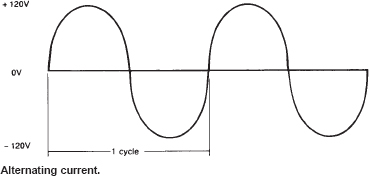These are also other measurements you need to know
Units of Measurement (2)
Voltage, current, and resistance are basic measurements of electricity, but when you need to apply electricity to television, you will need to know some other measurements. Among these are frequency, hertz, and AC frequency.
Frequency
Frequency is an action that repeats itself. If you have an electrical circuit that puts out repeated and equal bursts or pulses of energy at 100 of those pulses a second, the frequency of that circuit is 100 pulses per second. But we measure frequency in hertz (Hz), so the frequency is 100 Hz.
AC Frequency
In our earlier discussion of AC, you learned that the flow of electrons in AC current constantly changes direction. If the electricity in your home is 120 V AC, the electricity will go from 0 V up to +120 V, back down to 0 V, continue down to –120 V, and then go back up to 0 V. This alternation between 120 V of positive electricity and 120 V of negative electricity is one cycle. Your household electricity does this 60 times a second. So the frequency of your household electricity is 60 Hz. Thus, to be fully descriptive of the electricity in your house, you would say it's 120 V 60 Hz AC.
Impedance
Just as DC circuits had resistance, AC circuits have impedance. Impedance is the combination of resistance, capacitance, and inductance (discussed later). Impedance can help tell the production person if two or more circuits will interact well. The following oversimplified example may help you understand the concept. If your stereo amplifier has a speaker impedance of 8 Ω, this means that it is designed to hook up to speakers that have 8 Ω of resistance. If you connect your 8-Ω amplifier to your 8-Ω speakers, everything works great. But what happens when you connect that 8-Ω amplifier to speakers that have 10,000 Ω of resistance? Not much! The system just isn't designed to overcome that much resistance. On the other hand, if you have both an amplifier and speakers with 10,000 Ω of impedance, everything works just fine. But if you connect that 10,000-Ω amplifier to speakers that have 8-Ω resistance, you've got problems. You could destroy your speakers! They're just not designed to work with that amplifier. You have what's called a mismatch. Impedance is an important factor when integrating electrical components.

